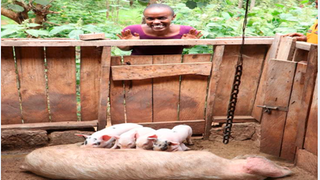
Sharon Mutiga feeds her pigs she keeps on her farm in Tigania West.
| Gitonga Marete | Nation Media GroupSeeds of Gold
Premium
Before siting your livestock farm, consider this...
What you need to know:
- Many would-be farmers wanted to know how to start pig farming and which areas are suitable for the venture.
- It is important for all farmers to know that their farms are businesses that can be affected by both public and private projects.
The overwhelming feedback I have received on the recent articles on pig farming indicate there is a lot of interest in pig production. Many would-be farmers wanted to know how to start pig farming and which areas are suitable for the venture.
Sally from Kiambu, however, stood out. Hers was re-establishment of pig farming after being forced to stop two years ago. She was doing very well with her pigs but then a national development project put her out of business.
“How would I have known that upgrade of the Nairobi-Naivasha Highway would cost me my pig farm?” Sally mused on phone.
The pig farm is located about 100 metres from the highway with an earth access road. It has a fairly steep terrain. There is an alternative but torturous access road on the lower end of the farm accessible only during the dry season.
Feeds to the farm and veterinary services were supplied from the highway side. Mature baconer pigs would be collected for slaughter from the lower dry weather road.
When the construction of the highway picked up, it became impossible to access the farm from the highway due to deep excavation and heaping of soil on the road reserve at the entrance. The high incline of the terrain made it difficult for the contractor to provide the farm with a temporary access.
Sally shifted the supply route to the lower road but it became very expensive as suppliers charged highly for transport and time spent negotiating the long rough road. The road was impassable during the rainy season.
In addition, the cost of labour to manually haul large quantities of feed from the lower road to the farm store made the operation unprofitable.
Sally watched as her business hurtled towards closure. Like any other investor, she could not continue running a business that has no path to revival. She sold all the pigs and promised herself to reopen once the road construction was complete.
I enquired if she had considered asking for compensation from the government. She said she did but she was informed the farm had not been in the list of businesses that would be affected seriously by the road.
I quickly thought that the farm must have been missed at the impact assessment stage. I asked her if she had attended any of the public participation meetings that are conducted during the project conception but she said she was not aware of such happenings.
It is important for all farmers to know that their farms are businesses that can be affected by both public and private projects. One is supposed to be aware of any projects that come up in their areas and find out how they would affect their properties and businesses. Where there are adverse effects that would lead to losses, those effects are supposed to be officially documented, given monetary value and marked for compensation if there are no other ways of mitigating them.
Sally’s farm was now accessible from the highway and she needed me to assist her in reopening it. She wanted to maximise use of the land and correct any structural designs lapses that may have been in the original structure.
Further, she wished to expand the farm to produce at least 50 baconers per month, up from the 25 baconer she used to do. She now wanted to know if the available land and structures would be sufficient to deliver the new target to compensate for the growth lost in the last two dormant years.
I always say if I knew I would spend my working life crunching numbers, I would have studied finance. Sally’s statement sounded very easy but it required me to consider myriads of factors before I could answer.
First, I had to work out the number of sows and boars that she would need to produce 50 baconers every month. The sows came to 30 considering that each on average produces 10 baconers to maturity of six months and gives birth twice per year. I adjusted that to 36 sows to cater for any misses in the breeding and production programme. She would also need two boars.
I visited the farm to review the existing structures and available land. I was armed with the data on various pig farming requirements including space for each pig at the different stages of production, type and quantity of feeds required daily by each pig and the daily water intake needs for each animal. I also had data on daily urine and manure production for each pig to aid in designing the manure handling provisions.
I toured the farm with Sally and her building contractor. We painstakingly took the measurements for the existing structures and the space available for expansion. The farm space appeared tight for Sally’s production target and only precise calculations would determine whether it would be sufficient.
It took me one week and an extra visit to get back to Sally with the good news. The numbers had given her the go ahead to produce at least 50 baconers per week. Her expansion would comprise 18 new pens for nursing mothers and expansion of the biogas plant and manure composting pits. I look forward to seeing the new-look farm with enhanced production in operation.





